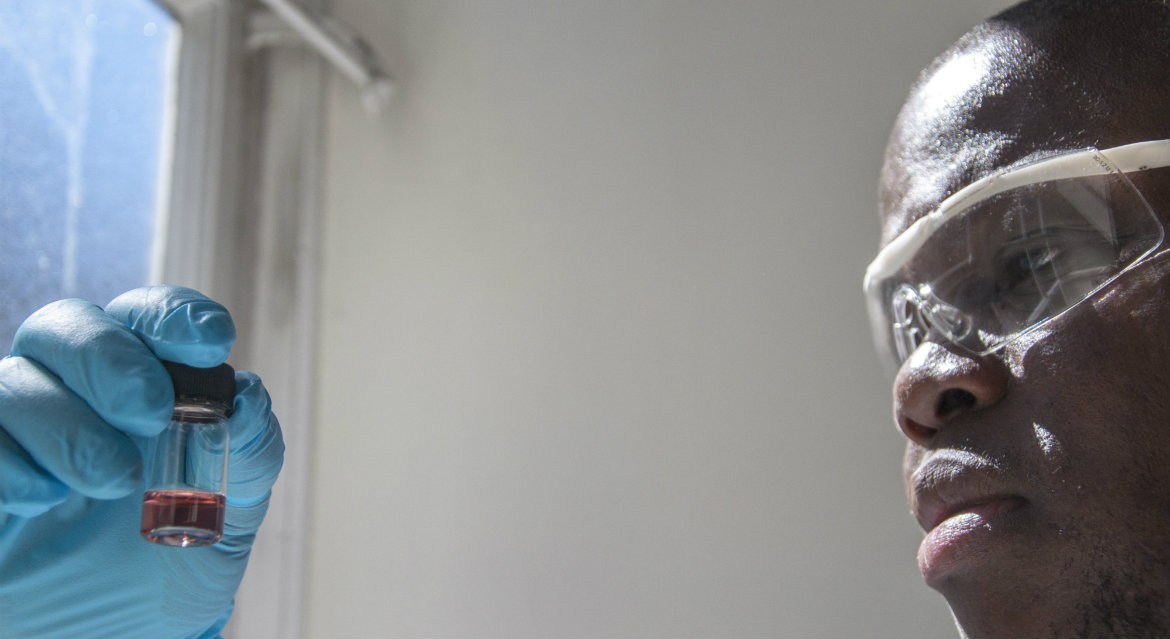New way of testing for cocaine discovered
Published On Thu 14 Mar 2019 by Grant Hill

Image is credit G.S. Thomson 2018
Researchers from the University of Dundee have developed a new chemical sensor for cocaine that may lead to potential new point of seizure tests for police officers, customs officers, prison officers and medical professionals who routinely test for controlled substances.
The new, specific colour-spot test has been developed by Dr Oluwasesan Adegoke and colleagues at the University’s Leverhulme Research Centre for Forensic Science (LRCFS).
Forensic laboratories are often called upon to identify tablets, liquids and unknown powders that may contain a controlled drug but, in many cases, the first responding officers seek to determine whether or not a suspected substance contains an illicit drug using an ‘off the shelf’ presumptive test kit.
These commercially available chemical spot test kits have been intensively used by law enforcement agencies for decades but their underpinning chemistry remains speculative or unknown in some cases. As a result, they are increasingly being challenged in terms of specificity, particularly as new drugs emerge onto the illicit market.
Mixtures of several drugs within powders can give a false positive reading, which could lead to either controlled substances being undetected or a person being incorrectly charged with possession of a particular drug.
In response to this, Dr Adegoke has utilised a buffer solution that the suspected cocaine is dropped in before being mixed with other sensor components. Within two minutes, a clear colour change specific to cocaine was seen. The analysis of several substances and drugs showed no interference to the sensor, demonstrating its selectivity to cocaine.
“This will obviously be of interest to law enforcement and other agencies,” said Dr Adegoke. “When starting this project we were trying to overcome certain challenges in the detection of controlled substances, one of which is the false positive readings for cocaine arising from the presence of several different compounds.
“This test is very specific to cocaine. We tried it with other substances and it wasn’t found to work. It takes advantage of cocaine’s unique chemical structure and the chemicals in the sensor have a strong affinity to the drug in comparison with the others we tested.
“We hope to do a follow up study in the future which may involve detecting cocaine in urine which will have relevance to medical professionals because if someone is experiencing health problems then they want to know what they have taken.”
The research has been published in the latest edition of the journal Sensors and Actuators B: Chemical.
The method developed by LRCFS staff uses a novel hybrid fluorescent nanozyme peroxidase-mimic catalytic sensor to detect the presence of cocaine. Nanozymes are nanomaterials-based enzyme mimics that are produced synthetically to mimic the properties of natural enzymes, proteins that speed up and facilitate reactions in living things.
Dr Adegoke added, “Hybrid nanozymes hold great promise for application in forensic science. This work is an excellent proof-of-concept colorimetric sensor technique that with a tweak of chemistry can be exploited for the detection of other targets of forensic interest.”
The Leverhulme Research Centre for Forensic Science is a 10-year £10 million funded research centre which aims to disrupt the current forensic science ecosystem.
The full paper is available to read here.
For media enquiries contact:
Grant Hill
Press Officer
University of Dundee
Nethergate, Dundee, DD1 4HN
Tel: +44 (0)1382 384768
Mobile: 07854 953277
Email: g.hill@dundee.ac.uk